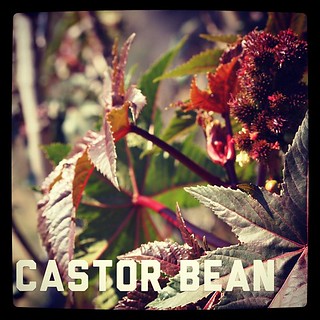Castor Bean (Ricinus)
While this plant is widespread throughout California, it is classified as an invasive plant and threatens to crowd out true native plants. That said, I have often seen this plant used as an ornamental in more temperate areas where is not hardy and therefore does not over-winter. This photo was taken during our hike in an area of the Hollywood Hills in the Santa Monica Mountains. You can read more about this trip in this post, Places LA: Trebek Open Space and Briar Summit Open Space Preserve, Santa Monica Mountains
The castor oil plant, Ricinus communis, is a species of flowering plant in the spurge family, Euphorbiaceae. It belongs to a monotypic genus, Ricinus, and subtribe, Ricininae. The evolution of castor and its relation to other species are currently being studied using modern genetic tools.[1]
Its seed is the castor bean, which, despite its name, is not a true bean. Castor is indigenous to the southeastern Mediterranean Basin, Eastern Africa, and India, but is widespread throughout tropical regions (and widely grown elsewhere as an ornamental plant).[2]
Castor seed is the source of castor oil, which has a wide variety of uses. The seeds contain between 40% and 60% oil that is rich in triglycerides, mainly ricinolein. The seed contains ricin, a toxin, which is also present in lower concentrations throughout the plant. — Wikipedia.org
